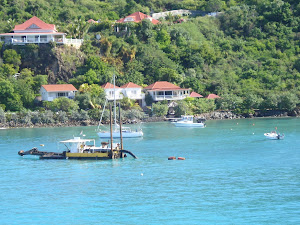Les raisons sont nombreuses et diverses. Nous ne pouvons les énumérer toutes, mais elles résultent autant de phénomènes naturels que de l'impact humain. La barrière de corail, grâce a sa hauteur, permettait de réduire la force des vagues de trois a quatre fois. Le blanchiment du corail, l'urbanisation de la baie de Saint-Jean et les pollutions diverses dont certaines matières organiques provenant d'eaux usées ont entraînéla mort de celui-ci. L'effet du cyclone Luis a casse cette barrière frangeante permettant a la mer d'entrer dans la baie avec beaucoup plus de vigueur.
La puissance plus grande avec laquelle la mer entre aujourd'hui et l'urbanisation des hauteurs et de la plaine de Saint-Jean ont accéléré le mouvement d'érosion de la plage, et de ce fait, ensablé également la barrière.
Aujourd'hui, la plage de Saint-Jean a disparu, ainsi que la vie marine de la baie. A la demande de la Collectivité de Saint-Barthélemy, des scientifiques ont réalisé des rapports afin d'initier une réflexion a long terme sur les causes et les solutions.
Dans la situation actuelles, une non intervention serait une catastrophe autant pour la baie en elle-même que d'un point de vue humain, pour les résidents de la baie de Saint-Jean.
L'Association des Hôteliers, soucieuse de l'environnement et de la qualité de vie a Saint-Barthélemy, a décidé de s'engager dans ce projet a long terme. La baie de Saint-Jean est en effet une richesse environnementale de l'île et qui profite autant a la population résidente qu'aux touristes.
Le projet de développement durable est envisage en différentes étapes, avec l'autorisation et sous la surveillance de la Collectivité.
La première étape, la plus urgente, consiste a désensabler la barrière de corail afin de recréer le mouvement du courant qui existait a l'origine. Le désensablement de la barrière et le réensablement de la plage de Saint-Jean va permettre aux scientifiques d'étudier de manière plus précise la courantologie de la baie et d'exécuter des relevés adéquats.
Une fois la barrière désensablée, l'étape suivante sera d'analyser la possibilité d'une revitalisation de la barrière de corail. Pour ce faire, les scientifiques peuvent aujourd'hui transplanter du corail vivant. Certaines études sont nécessaires pour valider cette hypothèse mais de telles transplantations ont eu lieu avec succès a Antigua et en Indonésie, ou des résultats positifs sont visibles après 7 ans.
L'objectif du projet est de revitaliser de manière durable et écologiquement responsable la baie de Saint-Jean. C'est un engagement a long terme qui comprend des actions urgentes telles que le désensablement de la barrière et le réensablement de la plage, ainsi que des actions a plus longues durées comme les études scientifiques qui portent sur quelques années et la transplantation du corail.
St Jean bay has been transformed over the years in an irremediable way. Today, part of the beach no longer exists, coral reef is dead, herbarium depleted and marine life has disappeared.
Reasons are multiple and diverse and result as much from natural phenomenon as they do from human impact. Coral reef, due to its height, permitted the reduction of the force generated in waves coming into the bay. Whitening of the coral reef, urbanization of St Jean bay and pollution have caused the death of the coral. Hurricane Luis had the effect of breaking the reef that rose above sea level at the time he hit in 1995. The result being waves entering the bay with more power.
The greater force with which the sea enters the bay today coupled with the St Jean neighborhood has further increased the erosion of the beach. This, in turn, has led to sand being deposited on the coral reef. Scientists, acting on the concerns of the Collectivity, have carried out reports in order to initiate a long term reflection to determine causes and solutions.
In today situation, a non intervention would be catastrophic for the bay itself, for the people who visit and for the residents of St Jean.
The Hotel Association of St Barth's, conscious of the environment and quality of life in St Barthelemy, has engaged itself to this long term project. Indeed, St Jean bay is an environmental resource for the island from which both the population and the tourists benefit.
This project of sustainable development is two-fold:
The first and most urgent stage is to liberate the coral reef from the sand that has accumulated over the years by taking the sand out of the barrier and putting it back onto St Jean beach. This will allow scientists to study in a more precise way the currents of the bay and to take some measurement.
Once the reef has been cleaned of sand, the second stage is to analyze the eventuality of revitalizing the reef barrier. A number of studies is needed to validate this possibility. Today's scientists can transplant live coral. Such transplantation has been successful in Antigua where positive results can been seen after seven years.
The goal of the project is to rehabilitate in a sustainable, ecological and responsible way the bay of St Jean. The project is a long term commitment which will involve both immediate and long term action as scientific studies and coral transplantation occurs.
.jpg)

